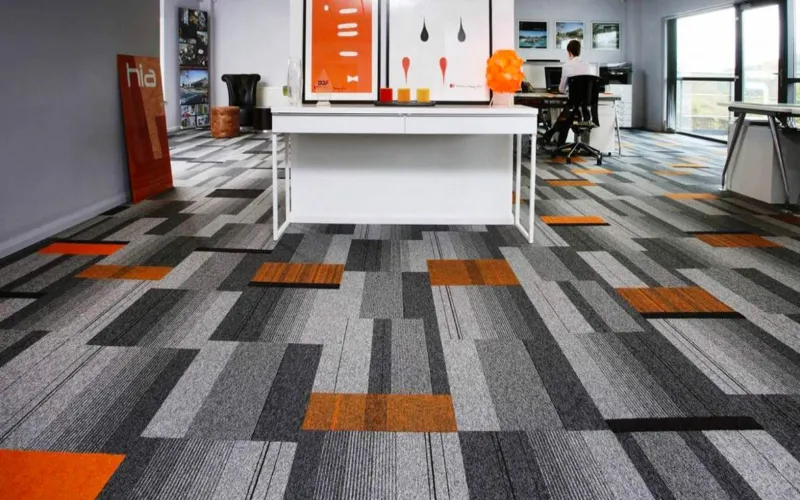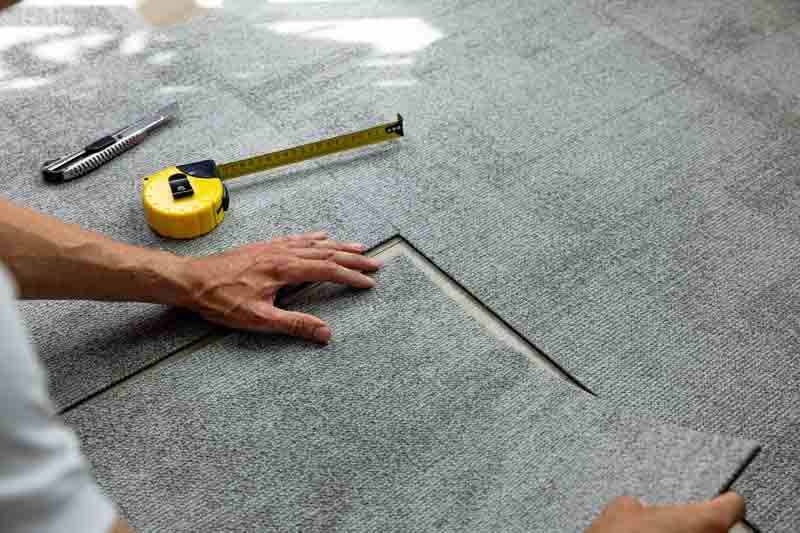Do you want to replace or remove damaged carpet tiles without making a mess? Then stay with us! In this blog, we will provide you with the best tips and simple methods to replace your worn-out carpet tiles with new ones. By following our step-by-step instructions, you can transform your residential and commercial buildings with the best solutions.

What Are Carpet Tiles? | A Brief Introduction
Unlike traditional wall-to-wall carpets, carpet tiles come in rectangular or square sections that can be placed individually. They come in versatile styles, creative patterns, and offer affordability and ease of installation for modern consumers. Available in smart installation designs, they can be installed with adhesive materials and click lock applications, saving you time, money, and energy. These budget-friendly solutions require minimal upkeep, are suitable for exhibitions or temporary events, and provide underfoot comfort for the users. Made with durable materials like nylon and polypropylene, they withstand heavy foot traffic and protect your floors from potential damage. These decorative floor treatments can be chosen in a range of styles, such as loop pile, cut pile, patterned tiles, shaggy tiles, modular carpet, broadloom carpet tiles, frieze carpet tiles, and many more.
| Type | Design | Benefits | Best For |
| Loop Pile | Made with loop fibers | Suitable for heavy traffic areas, requires low maintenance | Commercial buildings and office setups |
| Cut Pile | Fibers are cut to provide the desired plush look | Provides formal appearance and lasting comfort | Can be used in bedrooms and living rooms |
| Patterned Tiles | Eye-catching patterns | Add a dramatic touch and hide stains and dirt, offering a clean appearance | Suitable for creative living spaces |
| Broadloom Tiles | Imitates carpet rolls | Stylish floor coverings, seamless and luxurious look | Both residential and corporate spaces |
| Modular Tiles | Come in a variety of shapes and sizes | Support customized designs, offer a personalized appearance | Bedrooms, living rooms, office setups, and brand promotion |
| Frieze Tiles | Designed with tightly twisted yarns | Footprints resistant, maintain the original look | Family spaces and casual business settings |
Step-by-Step Process To Replace Damaged Tiles | Beneficial Tips
Carpet tiles can be installed through both a DIY process or by hiring a professional, and require less manpower as compared to traditional carpets. Below are some tips that you can follow to replace floor coverings with ease and maintain the functionality of your living spaces.
Remove The Damaged Tile
To replace the damaged tile, clear your room of furniture, and then begin the process. Locate the tile that needs replacement and remove it using dedicated tools. For this purpose, you can use a utility knife, scraper, or carpet trowel. By using flat tools, lift the tile and cut through any stubborn adhesive or tape for better results.
Prepare The Area
Clean the floor and scrape away any old adhesive to achieve the desired appearance for the new tiles. Remove any dust and debris from the floor surface before installing the new tile, using a vacuum cleaner. This step may not look important at the initial stage, but it helps in the longevity and enhanced functionality of the carpet tiles.
Prepare The New Tile
Cut the new tile to an accurate size and place it into the empty spaces. Also, check the directional arrow before placing the tile for an organized look. This step is important as placing the tile in the wrong direction will appear as a different shade, especially when the light reflects on it.
Seamless Installation
Apply double-sided tape or liquid adhesive to the subfloor for a strong grip and to achieve a slip-resistant surface. If it is a peel-and-stick tile, peel the backing of the tile before pressing it. Carefully position the new tile on the floor and press it down to the floor for even and smooth finishing. Make sure the tile is aligned with the surrounding tiles for a better look.

Common Mistakes To Avoid When Installing A New Tile
Installing new tiles requires patience, basic knowledge, and special techniques to create a seamless and soft appearance. They need aftercare to maintain their functionality, and with the smart strategies, you can prolong their lives. Here are common mistakes that people make, and you should avoid them at any cost.
Skipping A Roller
After the installation of the tiles, use a roller and press it on the tiles for a smooth surface. Many people skip this step, considering it an unnecessary protocol, but the professionals never make this mistake. So if you want to achieve an even surface, use a carpet roller.
Too Much Adhesive
Using too much adhesive can cause problems and create a mess. Avoid this mistake and do not overstretch the product. The more products you use, the longer it will take to dry and lengthen the process of installation.
Immediate Heavy Use
Another common mistake that people make is that they immediately start walking on the carpet flooring, which must be avoided. Wait for at least 72 hours before walking on the carpet tiles, and also avoid placing heavy furniture on them.
Dragging Furniture
Don’t drag your furniture, as it affects the grip and functionality of the floor coverings. Instead, lift the furniture and place it where you want it to be. You can also use furniture pads to protect the tiles and maintain their appearance for years.
Aggressive Vacuuming
Aggressive vacuuming damages the fibers of the carpet tiles and ruins their originality. For the first few weeks, vacuum gently and avoid using the vacuum cleaners with a rotating brush. For gentle cleaning, you can use a vacuum cleaner with a soft brush and clean your carpet without damaging its fibers.
Conclusion
Carpet tiles can be installed easily if you know the basic rules and special techniques to install them. By following the mentioned tips and avoiding the mistakes, you can enhance the functionality of your floor treatments and get both visual interest and practical benefits for your residential and commercial buildings.
